LAWN PHIX PRO PICK
The best starter fertilizer that I’ve used, and the one I recommend to all of my customers, is The Andersons 18-24-12. It’s the perfect 3-4-2 ratio of N-P-K, with 50% of its nitrogen being slow-release. This means you won’t get a surge of top-growth of your existing grass during seeding. The higher phosphorus really helps develop root growth which is essential for newly germinated grass seeds. Triple 19 or Triple 12 is a good secondary option, but scoop up this 18-24-12 if you can for the best results. It’s what I’ve been using on my own lawn – and professionally for over three years – when fertilizing during aeration & overseeding.
Whether you’re overseeding an established lawn, starting over after a full lawn renovation, or planting new grass seed on bare soil, choosing the right starter fertilizer is key.
Starter fertilizer for grass differs from other lawn fertilizers mainly due to the higher levels of Phosphorus (P). This number on the bag (the second number, or “P” of N-P-K) is generally the same as the Nitrogen (the first number on the bag, or “N” of N-P-K) or higher. And the rates of Potassium (the third number on the bag label, or “K” of N-P-K) are either the same or the lowest of the three.
Phosphorus promotes root growth which is vital for the early growth of new grass. Establishing strong roots systems and root development is the primary job of starter fertilizers.
Some other nutrients may also be added to starter fertilizers, including iron, sulfur, and manganese. Be sure never to use a fertilizer with crabgrass pre-emergent unless the starter fertilizer explicitly states “for seeding”. The herbicide will be “Mesotrione” (Tenacity) – never prodiamine, dithiopyr, or pendimethalin as these will prevent your grass seeds from germinating.
Below are a list of my top starter fertilizers to use when overseeding this fall or spring. I’ve rotated and tried these first-hand beginning in 2018 and highly recommend them all.
Table of Contents
1. Andersons Starter Fertilizer (18-24-12)
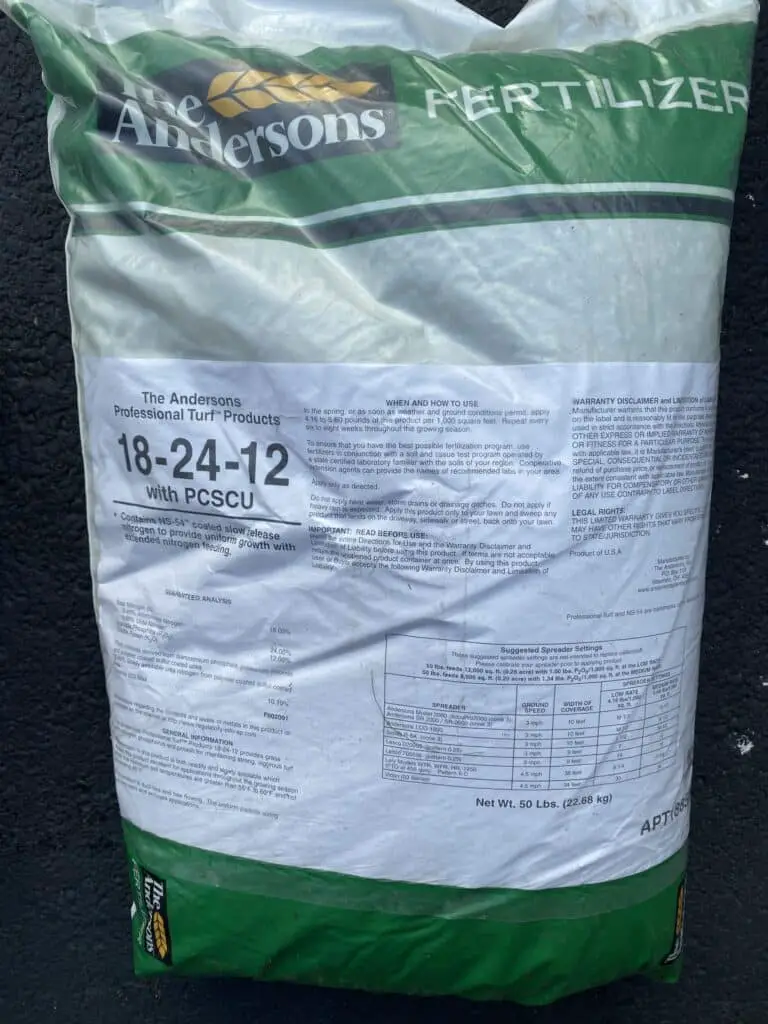
The Andersons starter fertilizer is the perfect fertilizer blend and ratio of Nitrogen, Phosphorus, and Potassium. This popular 3-4-2 starter fertilizer ratio contains polymer-coated,sulfur-coated urea (PCSCU), and the main one I recommend to everyone – including Lawn Phix customers. This coating provides a long and steady release of nitrogen into the soil. This consistent slow-feeding is vital to the seed and plant growth, allowing a longer feeding from a single starter fertilizer application.
Another good reason for this slow, timed-release nitrogen fertilizer is for overseeding existing lawns. Suppose too much fast-release nitrogen fertilizer is applied to a lawn. In that case, the existing grass can uptake the fertilizer and nutrients faster than the grass seed – or even newly-germinated grass. This can cause excessive top growth and crowd out the grass seed and new seedlings.
Apply approximately 4 pounds (lbs.) of Andersons starter fertilizer per 1,000 square feet (sq. ft.) to apply 1 lb. of P to the soil, and 3/4 lbs. of N. At this rate, this 50 lbs. bag of starter fertilizer will cover approximately 12,000 sq. ft. of turf.
I set the dial on my Spyker to #5.3 and #19 on my Lesco spreaders.
There have been some recent supply chain issues, so these Andersons fertilizer products have been tough to stay in stock – so be sure to grab some now while they last.
Pros:
- High percentages of all N-P-K in an ideal ratio
- It covers a large area
- 50% slow-release nitrogen
Cons:
- It can sometimes be hard to find
Compare The Anderson’s 18-24-12 prices on DoMyOwn and Amazon.
Andersons Starter Fertilizer Label
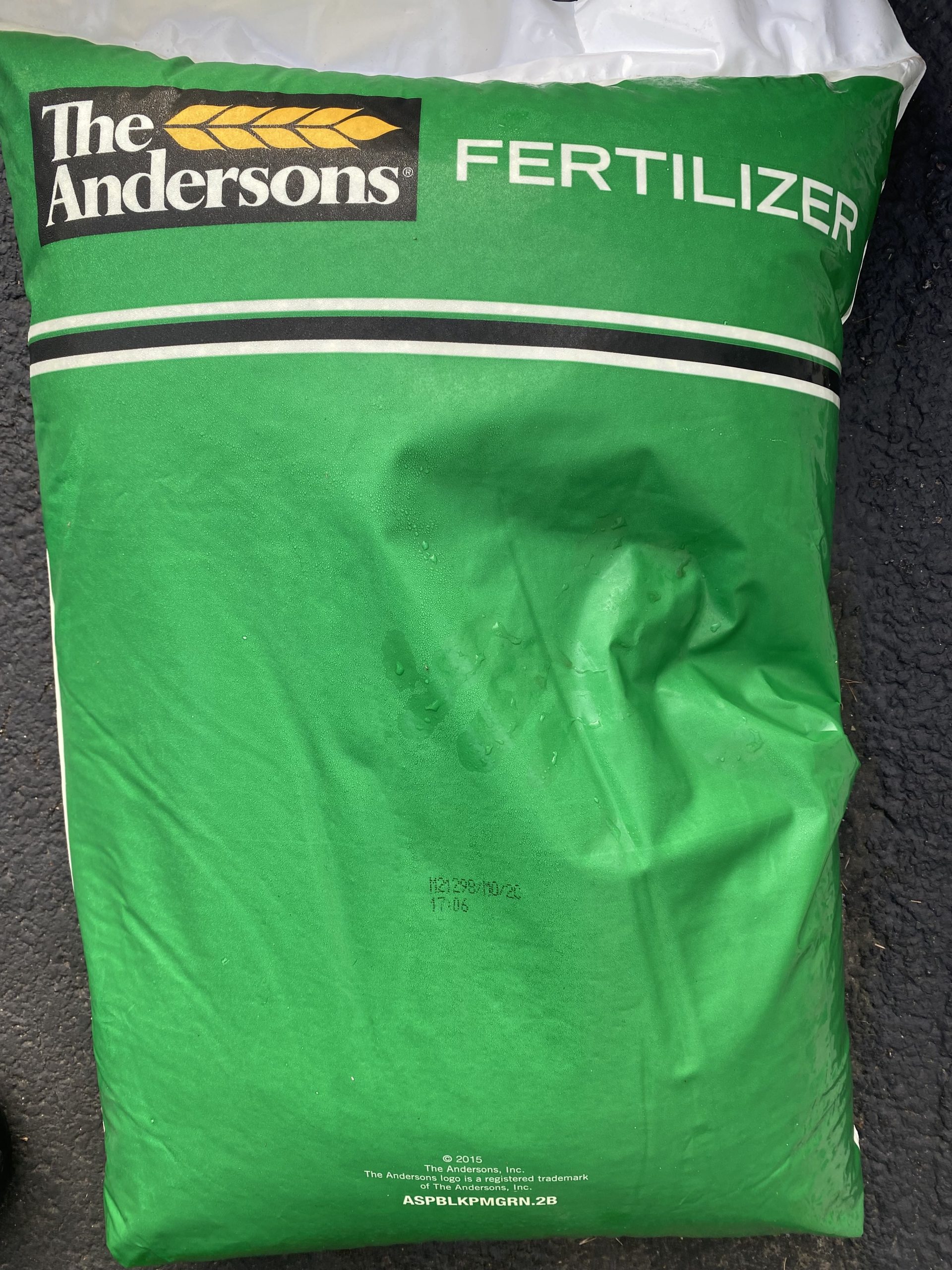
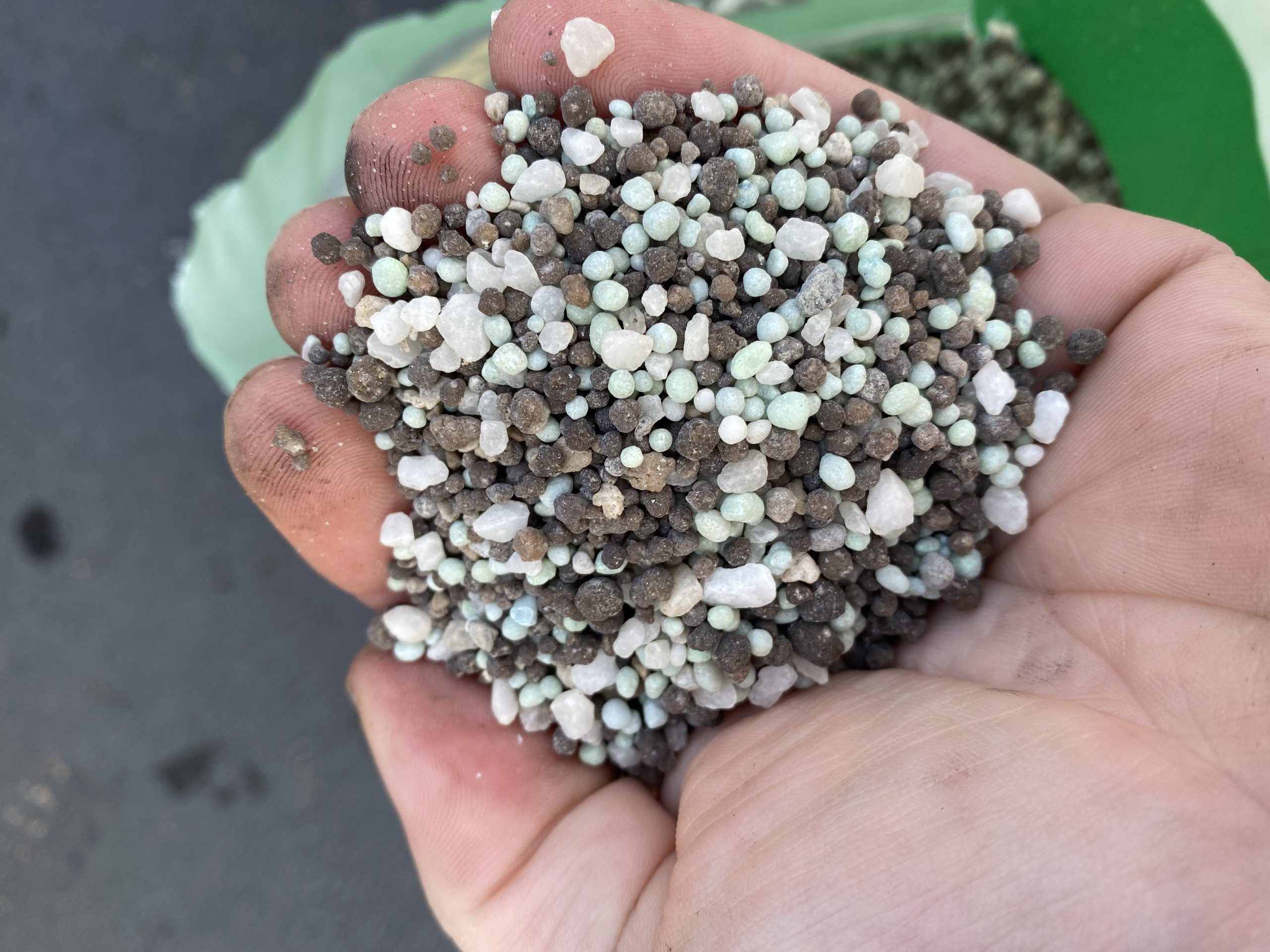
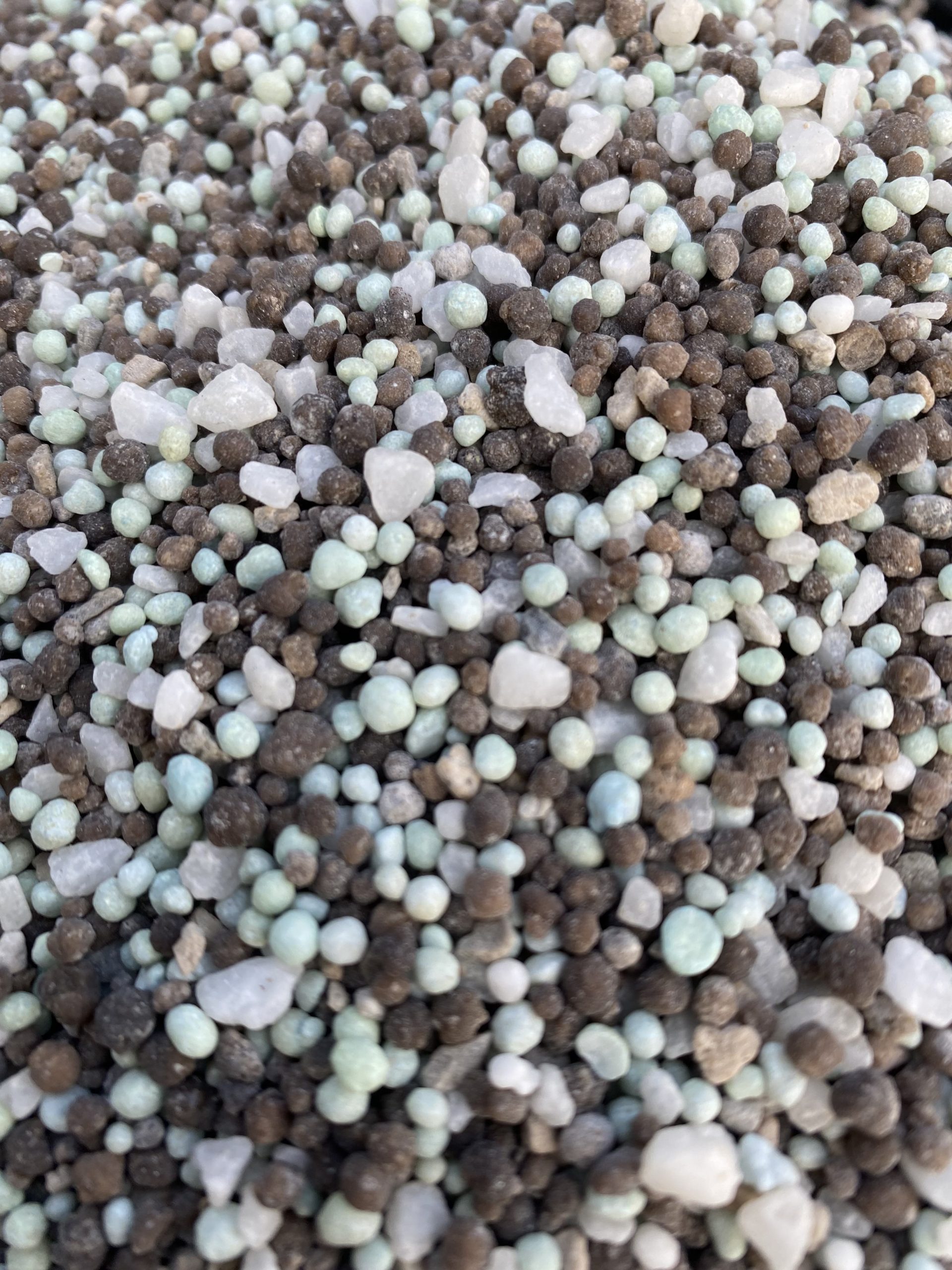
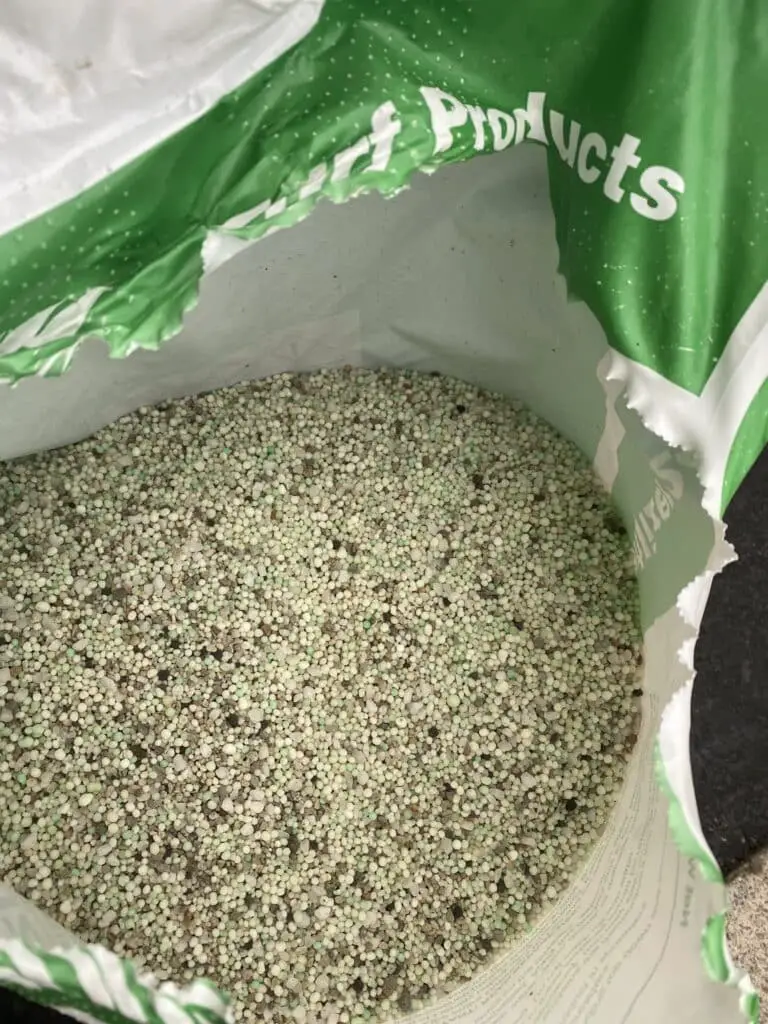
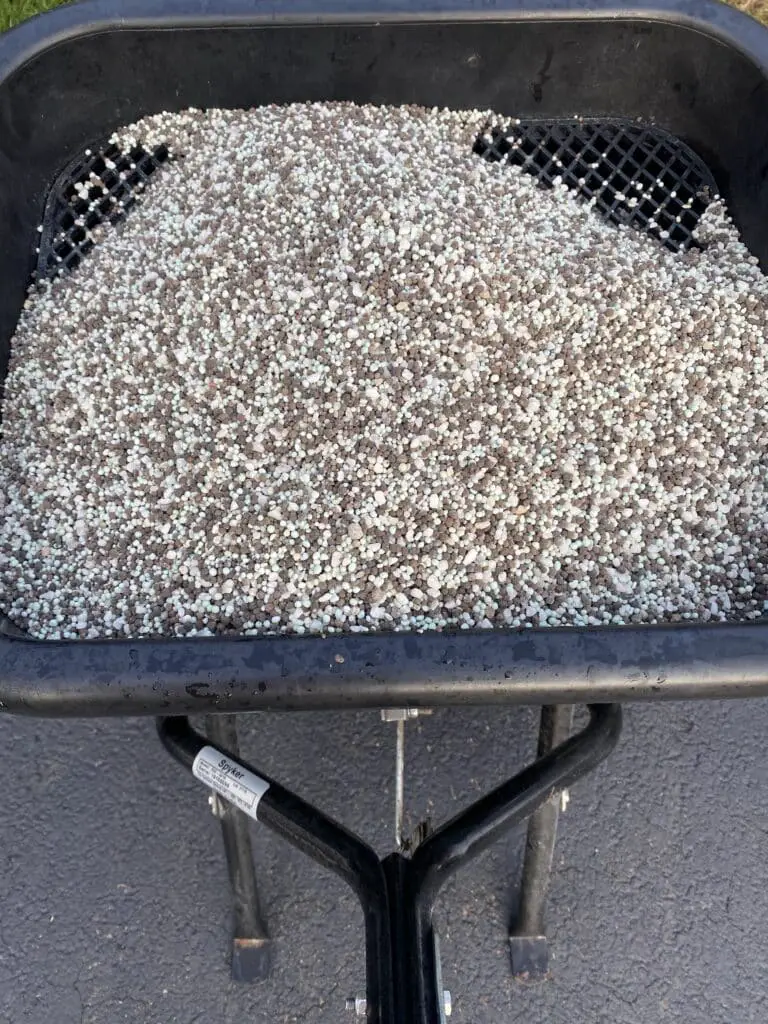
2. Yard Mastery Starter Fertilizer (12-12-12)
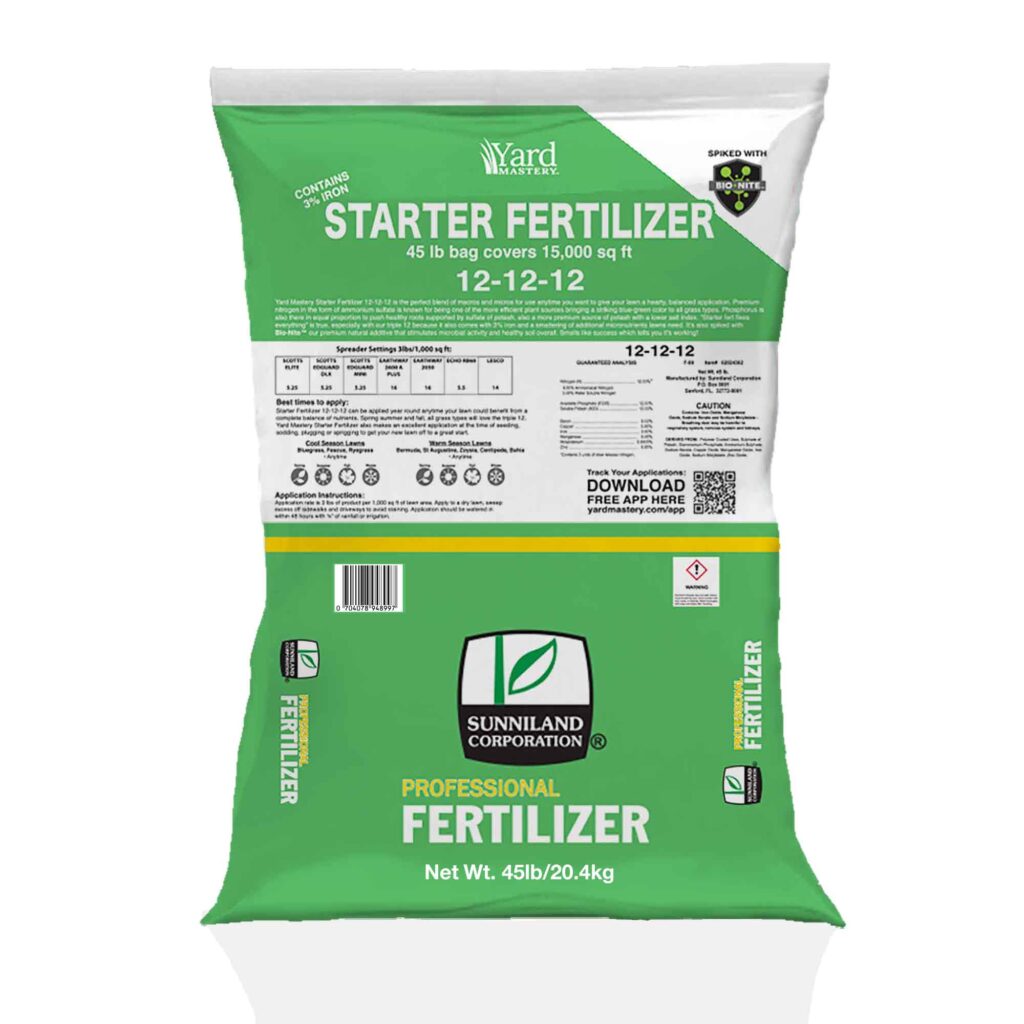
This even ratio of Nitrogen, Phosphorus, and Potassium is a very common starter fertilizer. Some other similar fertilizer blends you might see are 10-10-10 and 19-19-19. I like this “Triple 12” starter fertilizer from Sunniland/Yard Mastery because it also contains 3% Iron, Bio-Nite (which is a biosolid, like Milorganite, but from Florida), and other nutrients for the plant, including Boron, Manganese, and Zinc. Plus, the owner is Allyn Hane aka The Lawn Care Nut – the OG of online DIY lawn care – who knows a thing or two about fertilizers.
Apply 4 lbs. per 1,000 sq. ft. to deliver 0.5 lb. of nitrogen and phosphorus per 1,000 sq. ft.
Pros:
- Provides fast green-up and even amount of macros
- Even N-P-K ratios
Cons:
- Inconsistent prill sizes
Compare 12-12-12 starter fertilizer prices on Yard Mastery and Amazon.
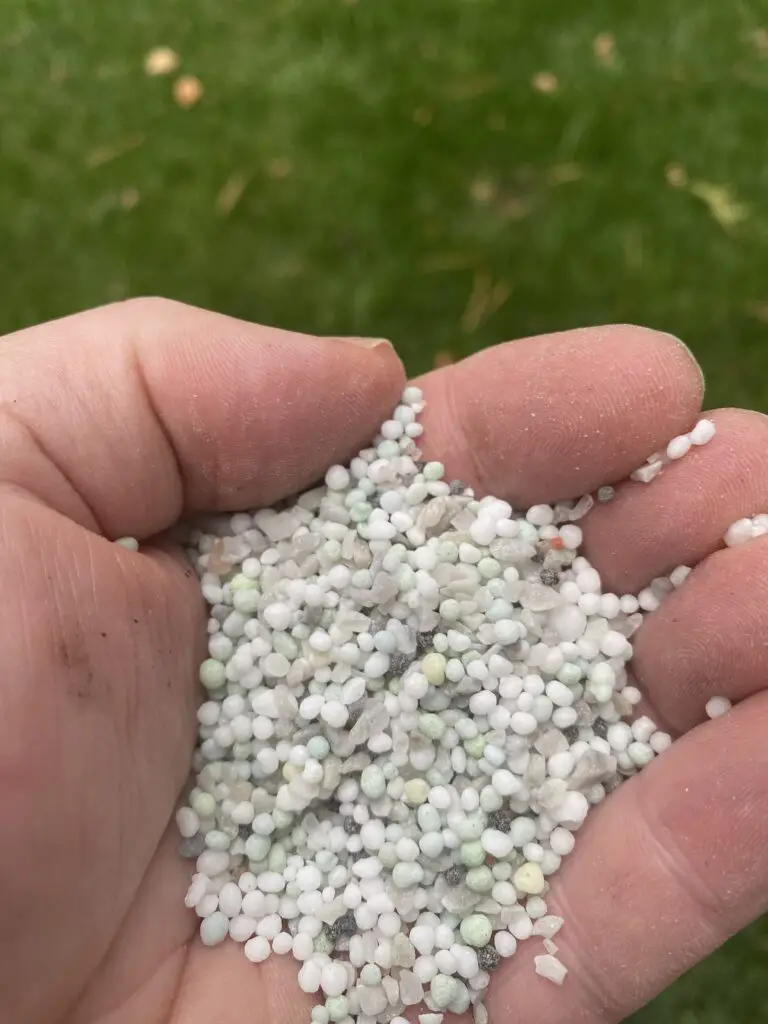
3. Ferti-Lome New Lawn Starter Fertilizer (9-13-7)
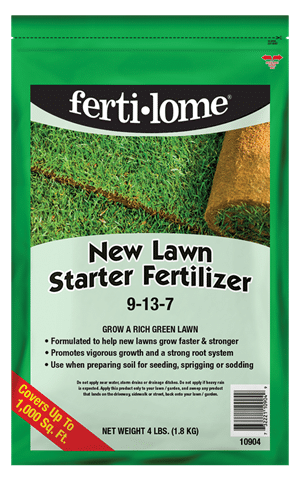
I like Ferti-Lome because they include a set of micronutrients in all their fertilizers – including this starter fertilizer for new lawns. Adding micros such as manganese, boron, zinc, and iron to new seedlings is always good.
I like the lower Nitrogen levels for overseeding existing lawns. Applying less nitrogen to an existing lawn will not promote quick top growth, allowing the new grass to develop before mowing is necessary. Ferti-Lome spread nicely from my Spyker spreader and germinated my TTTF grass seed in about 6 days.
Applying 4 lbs. per 1,000 sq. ft. will deliver 0.52 lbs. of P per 1,000 sq. ft.
Pros:
- Perfect N-P-K ratio for starter fertilizer
- Contains micronutrients
Cons:
- Low percentage of Nitrogen compared to most other starters
Compare Ferti-Lome 9-13-7 prices on DoMyOwn and Amazon.
Ferti-Lome New Lawn Starter Fertilizer Label
4. Scotts Turf Builder Starter Fertilizer (21-22-4)
There are only a few Scott’s products that I like and this one is the top of the list. Scotts Turf Builder starter fertilizer is a 21-22-4 blend containing Mesotrione (Tenacity herbicide). This is a perfect all-in-one starter, particularly for those spring seeding and needing to prevent crabgrass.
Scotts starter fertilizer with mesotrione in a built-in crabgrass pre-emergent and can help control crabgrass and other grassy weeds for up to 30 days – all while delivering nearly a full pound of both nitrogen and phosphorus when applied at bag rates (17.2-pound bag over 4,000 sq. ft., or 4.3 lbs. of starter fertilizer per 1,000 sq. ft.).
I personally use The Andersons 18-24-12 with liquid Mesotrione whenever I am spring seeding. But this Scott’s is the best all-in-one and the one I recommend to everyone who needs to suppress crabgrass while seeding.
Prevent weeds in your new lawn and feed it at the same time.
Scotts Turf Builder Triple Action Starter Fertilizer Label
5. Jonathan Green Starter Fertilizer (12-18-8)
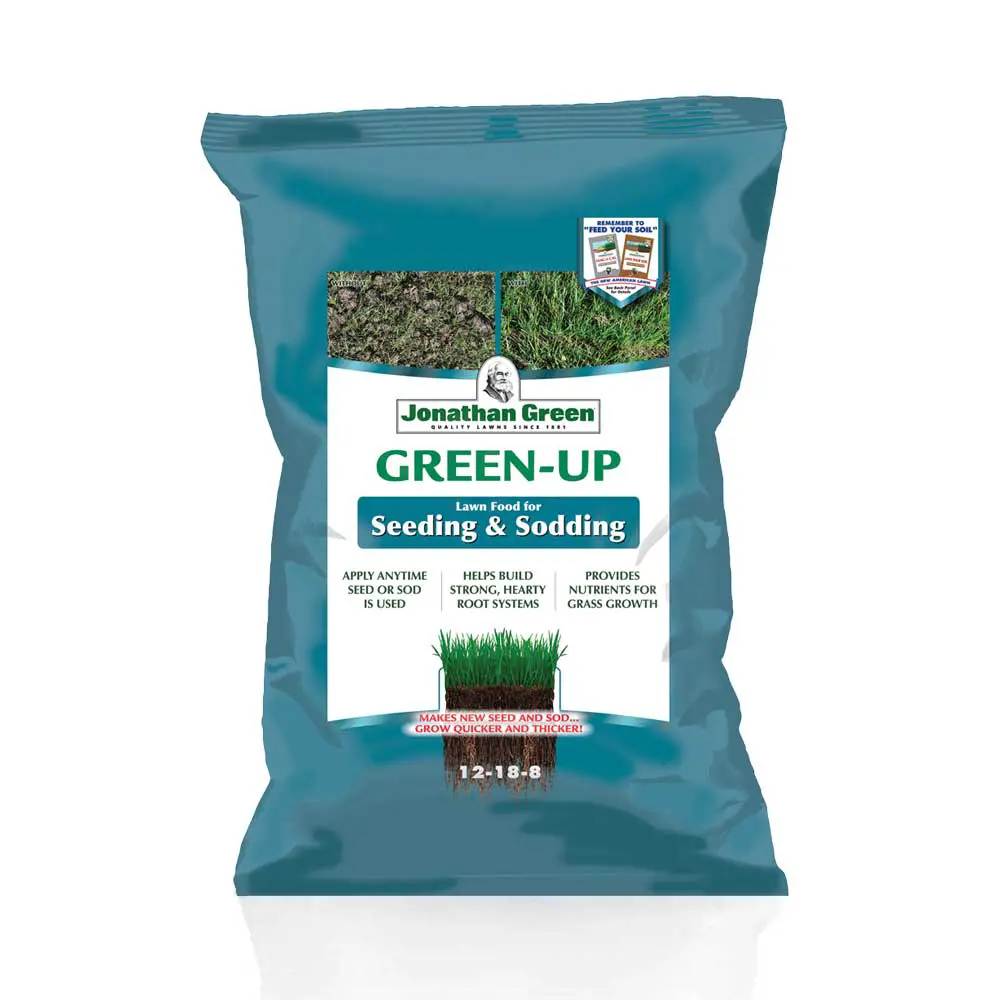
Jonathan Green develops some of the best grass seed around – from sod farmers to DIY homeowners – and their starter fertilizer is top-notch. They used to make a fantastic starter fertilizer with Siduron (a seed-safe pre-emergent herbicide similar to mesotrione) but unfortunately, their manufacturer stopped production. Hopefully, they’ll soon come out with another starter fertilizer with weed prevention because I had great results with that before.
One of the best things about this 12-18-8 Green-up starter fertilizer is its convenience – it’s available almost anywhere: Yard Mastery, Jonathan Green website, Amazon, and even local nurseries and hardware stores. Below is a picture of my 2019 renovation where I used Jonathan Green Green-up with GCI Turf seed on my 3,500 sq. ft. front yard reno. It worked great.

Other items to consider when overseeding
While starter fertilizers are the most important product for new seed and overseeding success (outside of the actual grass seed), you should also consider some other products for optimal success.
- Lime or Mag-I-Cal
- Organic fertilizer (slow release)
- Tenacity herbicide
Starter Fertilizers FAQ
What is the difference between starter fertilizer and regular fertilizer?
Generally, the biggest difference between starter fertilizer and regular fertilizer is that starter fertilizer will contain a much higher percentage of Phosphorus (P). Regular fertilizers you apply throughout the year will either contain much less or no P. The plant generally responds much quicker to starter fertilizer due to the high NPK rates.
What is the NPK of starter fertilizer?
The N-P-K varies from different products and manufacturers. Some have even ratios such as 19-19-19, while others will have a 3:4:2 ratio or similar (like 18-24-12). But one common element is that they will all contain higher levels of Phosphorus (P) to promote strong roots and root growth.
Do you really need starter fertilizer?
Yes, the main reason is Phosphorus. This promotes root development. Growing strong roots is essential for the early growth of new grass.
Can I use starter fertilizer all year?
No, for a couple of reasons.
1. You do not want to fertilize and push growth all year. For example, cool-season grasses will naturally want to slow down in the hotter summer months. Adding fertilizer, particularly starter fertilizer,
2. Some states (such as Massachusetts) are limited to certain products containing Phos. Some areas are at the time of seeding only, or if the plant soils are deficient in P. Contact your local extension office for details, including the yield of all fertilizers and nutrients in your specific region.
Starter Fertilizers on Amazon
Nitrogen and Phosphorus (and Potash)
The high percentage and ratios of two macronutrients are what make a starter fertilizer a starter fertilizer, and perfect for seeding. The nitrogen promotes lush top growth while phosphorus is essential to root growth and root development. The ratio of N to P is either even (1:1) or more phosphorus than nitrogen (1:2 or 3:4).
Common starter fertilizer blends are 1:1:1 (e.g. 10-10-10) and 3:4:2 (e.g. 18-24-12). Other non-starter fertilizers contain much lower P (18-3-6) or none at all (e.g. 24-0-6).
The potassium, or potash, is the “all-around” macronutrient. This helps the plant in stressful climates such as excessive heat and drought.

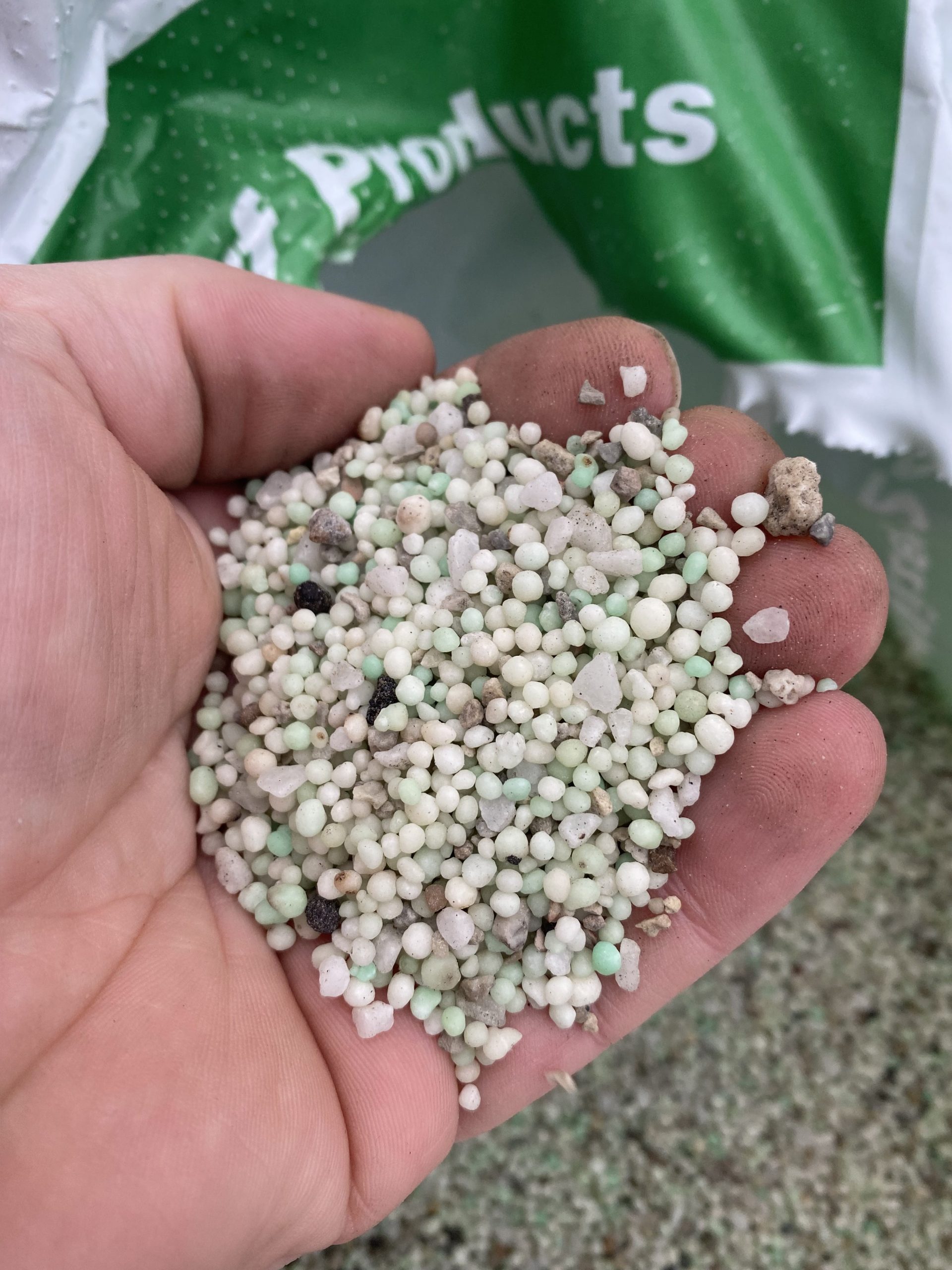
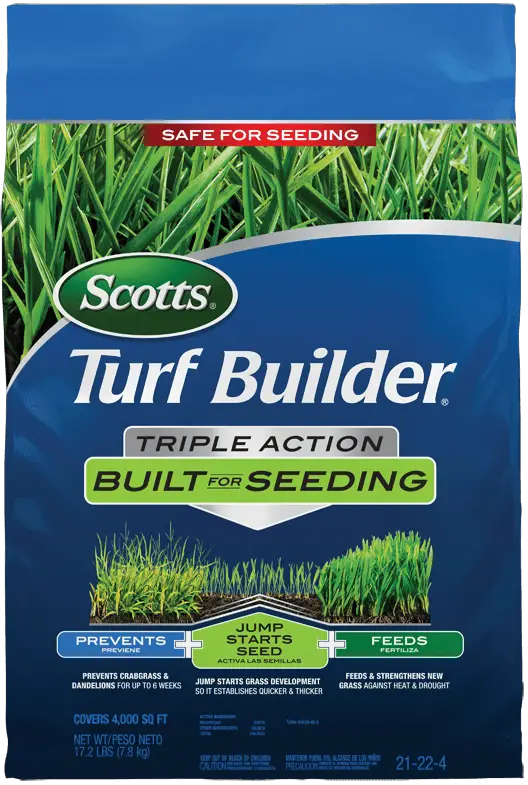
i live in north east and my soil test shows excessive levels of phosphorous (even though i’ve only used JG products w zero P). Do i need starter fertilizer to overseed tall fescue this fall? and what would you recommend? i plan on aerating and putting Air 8 and Love My Soil bc I have clay soil then seed and then putting down JG Winter Survival in late Oct about 6 weeks after seeding. i also want to add iron bc of yellowing lawn. thank you and great site!
Hi Andrea. Sorry for the delay! Thank you for your comment. I would still apply a starter fertilizer. The phosphorus levels in your soil test are good to know, but all that may not actually be available to the plant. Adding soil amendments like humic acid will allow those nutrients to be more available to the turf and allow for better uptake. I hope this helps and good luck this fall!